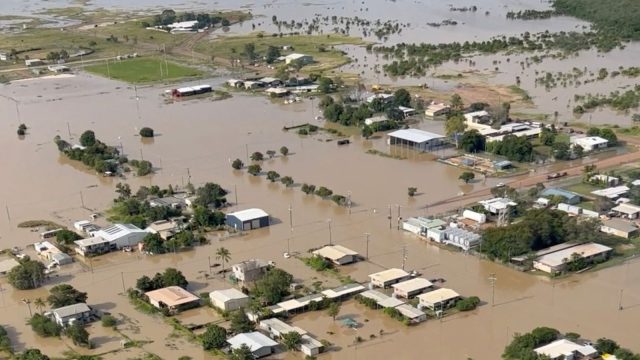A record-breaking flood has hit Australia’s Queensland state with residents being told to limit their movements due to crocodile-infested waters.
Almost 100 people were evacuated to higher ground in the worst-hit remote town of Burketown, around 1,300 miles (2,100km) northwest of state capital Brisbane following heavy rainfall in the past week.
The Gregory River peaked at 12.3 metres, topping a previous record of 6.78 metres (22.2ft) by almost double, according to the Sydney Morning Herald.
Queenstown Police have warned Burketown residents to limit their movements in the flood water due to recent crocodile sightings.
“Due to the current conditions, it is unsafe for displaced people to return to their homes and police remind residents to limit movement in the flood water due to unseen hazards and recent crocodile sightings,” police said.
Aerial images of Burketown, show properties and swathes of land submerged underwater.
Police also released footage of a baby kangaroo being saved from crocodile-infested floodwaters by a helicopter pilot.
The force said the pilot flew over and spotted “two very large crocs nearby”, before returning the kangaroo to dry land.
Dan McKinlay, chief executive of the local council responsible for Burketown, said on Sunday that 97 residents had been airlifted out in the past 48 hours.
Water levels in the area were “at heights not previously known” and the town looked like it was “sitting in the middle of an ocean”, he told ABC radio.
Australia’s Bureau of Meteorology predicted water levels in the area would peak on Sunday and said it had already surpassed a March 2011 record of 6.78 metres.
Read more:
California hit by ‘life threatening’ flash flooding
Child among four dead in New Zealand cyclone
The 2011 record was topped after up to 293 mm of rain fell on Thursday and Friday, the Bureau of Meteorology said.
The crisis comes after frequent flooding in Australia’s east over the last two years due to a multi-year La Nina weather event, including once-in-a-century floods that hit remote areas in the neighbouring Northern Territory, in January.










![Business tycoon in Novrongo to bury late father in a car [Video]](https://ghananewss.com/storage/2023/05/business-tycoon-100x75.jpeg)







